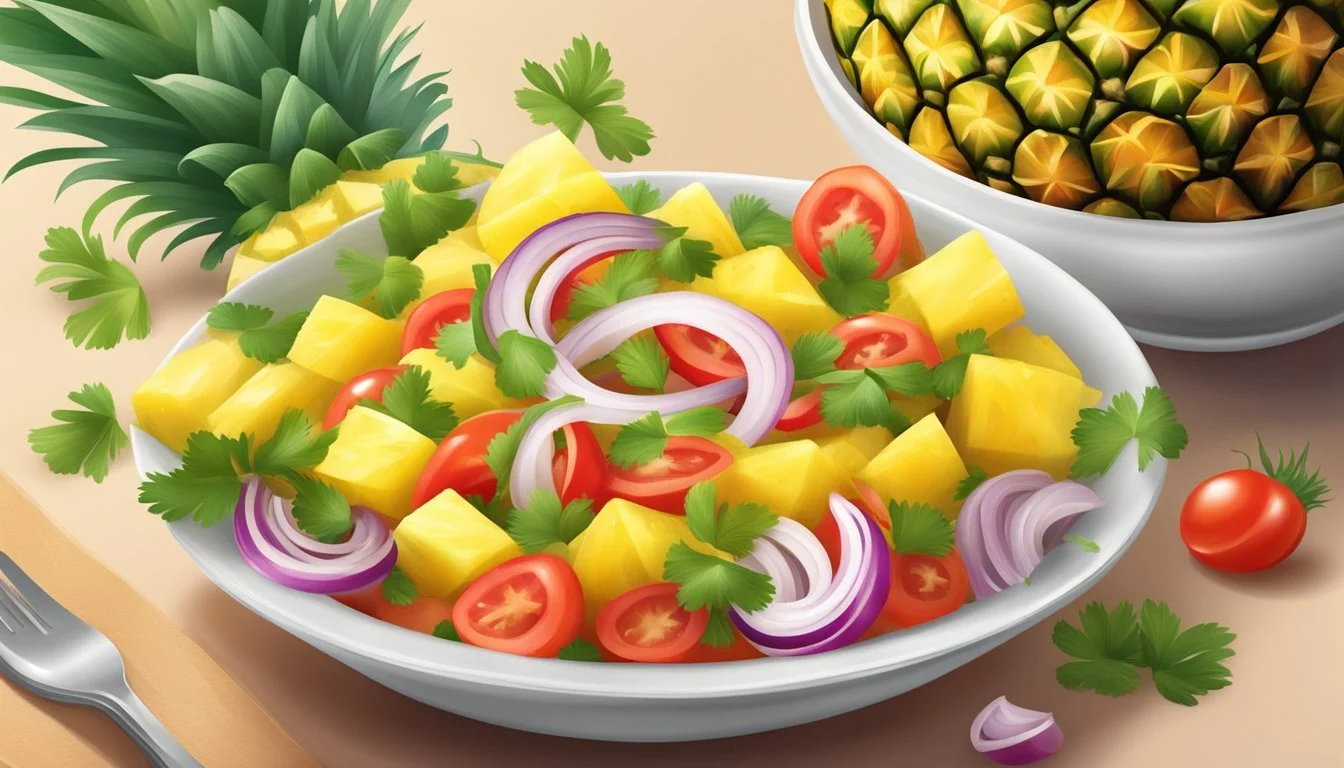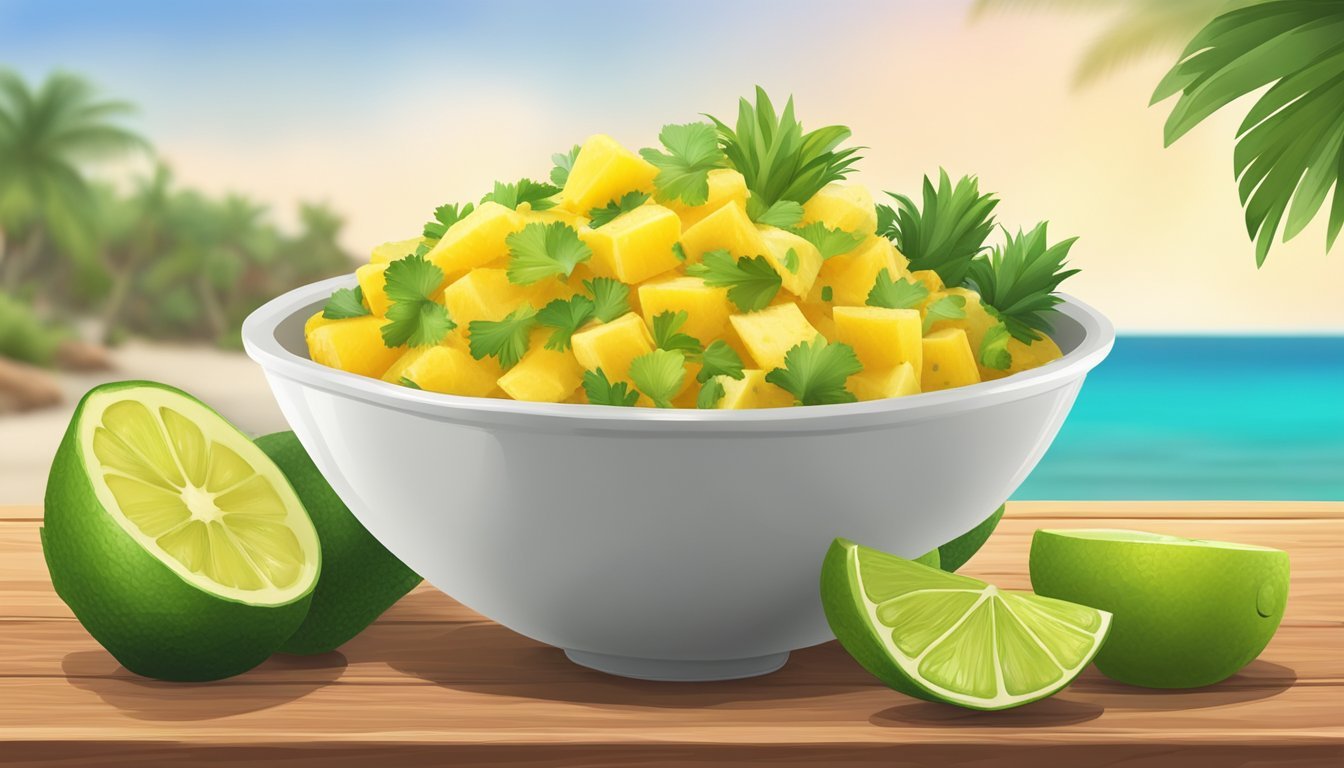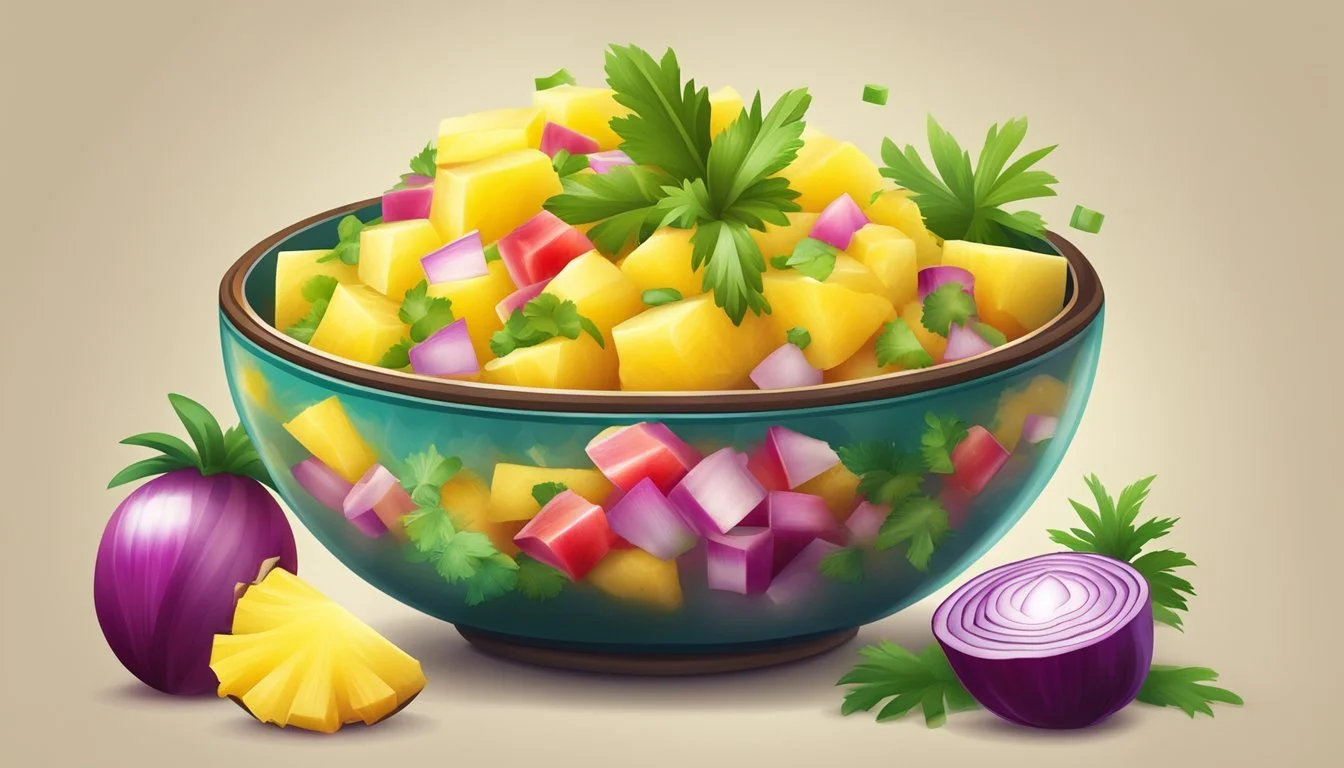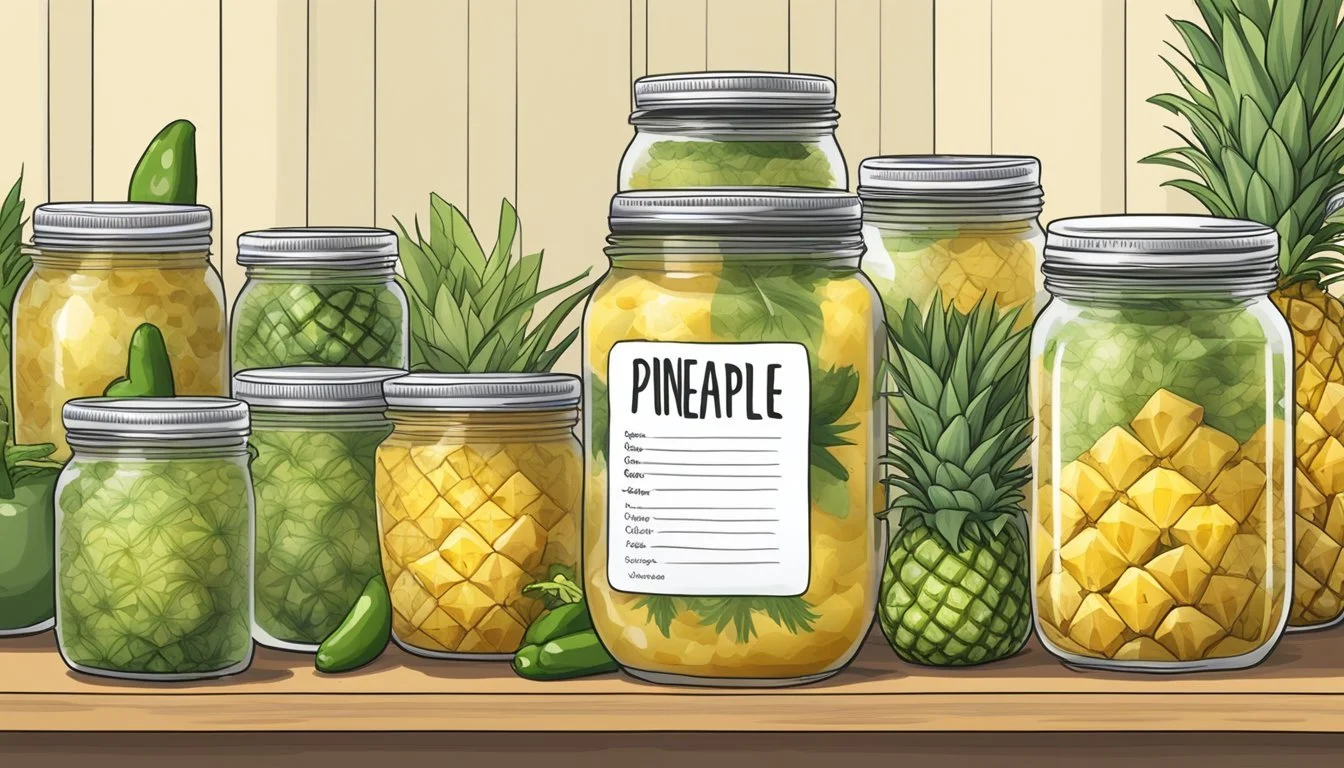Pineapple Core Salsa
A Tangy, Tropical Condiment Unveiled
Pineapple salsa is a vibrant and flavorful condiment that marries the sweetness of pineapple with the zest of citrus and the kick of chili peppers. This tropical salsa variant stands out for its unique use of the pineapple core, a part often discarded as too tough and fibrous. However, with the right preparation, the core can be transformed into a delightful addition to this zesty salsa. Incorporating the core not only minimizes waste but also adds a crunchy texture, complementing the softer fruit pieces and crisp vegetables.
To make pineapple core salsa, the core is diced finely to ensure it melds seamlessly with the other ingredients, balancing out the flavors and textures. Traditional recipes generally call for fresh pineapple tidbits, and by utilizing the core, the salsa takes a twist on the conventional approach while enhancing the pineapple presence throughout the dish. The usual suspects of onion, cilantro, and lime join the ensemble, along with jalapeño or other peppers for heat, creating a condiment that's as versatile as it is tasty. Whether spooned over grilled fish, used as a dip for tortilla chips, or as a garnish for tacos, pineapple core salsa adds a tangy tropical flair to any meal.
Benefits and Nutrition
Pineapple core salsa blends the zesty flavors of pineapple with the added benefit of essential nutrients. This tropical condiment is not only a flavorful addition to dishes but also contributes vitamins and minerals to one's diet.
Health Benefits of Pineapple
Pineapple is renowned for its health-promoting properties. It is rich in bromelain, an enzyme that is believed to aid in digestion and reduce inflammation. Moreover, the dietary fiber found in pineapple supports digestive health and helps maintain regular bowel movements. Regular consumption of pineapple can contribute to a strong immune system, as it is an excellent source of vitamin C, a powerful antioxidant.
Nutritional Content
A careful analysis of pineapple's nutritional profile reveals its contributions to a balanced diet. Here is a succinct breakdown:
Calories: Pineapple is low in calories, making it a suitable option for those monitoring their calorie intake.
Fiber: A good source of dietary fiber, which is crucial for digestive health.
Sugar: Pineapple contains natural sugars, providing a sweet taste without the need for added sugars.
Vitamin C: Provides a significant amount of this immune-boosting vitamin.
Vitamin A: Contains small amounts of vitamin A, important for skin and vision health.
Iron and Calcium: Offers modest amounts of iron and calcium, essential minerals for blood health and strong bones.
Nutrition Table:
Nutrient Amount per Serving Calories Low Fiber Good Sugar Natural Sugars Vitamin A Present Vitamin C High Iron Modest Calcium Modest
When incorporated into a balanced diet, pineapple core salsa is not just a treat for the taste buds but also a boost for nutritional well-being.
Ingredients Breakdown
Creating pineapple core salsa involves a combination of tropical fruitiness with a kick of spice. The following subsections detail the essential components, explore the balance between sweet and spicy elements, and suggest optional ingredients for variety.
Essential Ingredients for Pineapple Salsa
Pineapple: The star of the salsa, pineapple should be ripe to provide the right sweetness and tang. It's usually finely diced for texture.
Red Onion & Cilantro: These add sharpness and a herby freshness, respectively, often in finely chopped form.
Lime Juice: A critical ingredient that adds a zesty citrus flavor and also helps to marinate the salsa.
Salt: Enhances flavors and balances sweetness.
Exploring Sweet and Spicy Elements
Red Bell Pepper: Brings a vibrant color and sweet flavor that complements the pineapple.
Jalapeno: This hot pepper introduces a spicy note. Removing seeds and membranes can temper the heat.
Optional Add-Ins for Variations
Fresh Cilantro: Although cilantro is an essential ingredient, additional fresh cilantro can intensify the herbaceous notes.
Other Bell Peppers (What wine goes well with bell peppers?): Adding different colored bell peppers can enhance the visual appeal and flavor complexity.
Fruit Variations: Mango or peach can be combined with the pineapple for additional sweetness and fruity flavor.
Preparation Guide
Creating a delightful Pineapple Core Salsa begins with careful preparation of the fresh ingredients. The process ensures each bite is infused with vibrant flavors and the perfect balance of tangy sweetness inherent to ripe pineapple.
Cutting and Prepping the Pineapple
A ripe pineapple is key for striking the right flavor. To start, one must slice off the top and bottom ends of the fruit, allowing it to sit upright. They should proceed to remove the skin, slicing from top to bottom, and ensure the eyes or brown spikes are trimmed away. The core, often discarded, is actually usable and imparts a subtle tartness to the salsa. Once the exterior is removed, they should cut the pineapple lengthwise, remove the core, and finely chop it into small, even pieces.
Mixing the Ingredients
After prepping the pineapple, it should be combined with other ingredients in a medium bowl. The usual companions include finely chopped red onion, diced bell peppers, and minced cilantro, contributing layers of flavor and texture. If they are using any additional fruits (What wine goes well with fruits?) or vegetables, these should be similarly diced or minced to maintain a uniformity throughout the salsa.
Adjusting the Flavor Profile
To customize the salsa, chefs typically marinate it for at least 15 minutes to meld the flavors together. Citrus juices from lime or lemon can be zested or squeezed into the mix for added zing, but one must ensure not to overshadow the pineapple's sweetness. Salt and pepper are sprinkled for seasoning, to taste. Those preparing the salsa have the creative freedom to add heat with jalapeños or a dash of spice, adjusting according to their desired flavor profile.
Serving and Pairing Suggestions
Pineapple core salsa brings a tangy and tropical twist to various dishes. Its versatility makes it a great condiment for an array of protein-centric meals and a delightful addition to snacks and appetizers.
Perfect Pairings with Protein
Pineapple core salsa pairs exceptionally well with proteins, elevating their flavors with its sweet and tangy profile. Here are some specific combinations:
Chicken: Grilled chicken breasts or thighs gain a refreshing edge when topped with pineapple salsa.
Pork: A spoonful of salsa on a tenderly cooked pork chop adds a burst of flavor.
Fish: Fish tacos are incomplete without the addition of a tropical salsa that complements the lightness of the seafood.
Shrimp: Marinate shrimp in a bit of the salsa before grilling for an infusion of flavors.
Accompaniments and Snack Ideas
This salsa isn't just for main courses—it's also a dynamic addition to snacks and smaller bites. Here's how it can be incorporated:
Tortilla Chips: Transform them into a gourmet snack by partnering with pineapple salsa as a dip.
Rice and Beans: Serve salsa alongside rice and beans for a wholesome and satisfying dish.
Quesadillas: Add some inside a quesadilla for a sweet and savory experience.
Nachos: Drizzle over nachos for a fruity twist to this classic appetizer.
Recipe Variations
Pineapple core salsa is a versatile dish, which one can easily adapt to suit personal taste preferences and desired flavor profiles. Experimentation with different fruits and levels of heat can lead to the creation of an array of delicious condiments.
Alternative Fruit Salsas
To expand the tropical flavors, one might consider mango salsa or peach salsa as substitutes for traditional pineapple. These fresh fruit salsas incorporate a similar sweetness but offer subtle taste differences and textural variety. For a classic take, one could also opt for tomato salsa, which provides a more savory experience. When making these variations:
Use ripe mangoes or peaches to maintain the sweet and tangy characteristic of the salsa.
The fruits should be diced uniformly for an even distribution of flavor.
Heat Adjustments for a Spicier Kick
Adjusting the heat in pineapple core salsa is simple:
For a milder taste, use fewer jalapeño peppers or remove the seeds.
To increase the spiciness, add chopped serrano peppers which pack more heat than jalapeños.
Remember that the capsaicin in peppers—what makes them spicy—can intensify over time as the salsa sits.
Creating a Sweeter Salsa
Achieving a sweeter salsa can be accomplished by adding natural sweeteners such as honey. This adds a deep sweetness that complements the tangy profile of the salsa. Additionally, one might try blending in sweeter fruits to the mix. To sweeten the salsa without overpowering it:
Drizzle a small amount of honey and adjust according to taste.
Combine with existing or additional pineapple to reinforce the sweetness while keeping the salsa fruit-forward.
Storing and Preservation Tips
When preserving Pineapple Core Salsa, maintaining its freshness is crucial. To extend the salsa's shelf life, proper storage techniques must be employed, including refrigeration and freezing methods.
Proper Storage for Freshness
To preserve the vibrant flavors of Pineapple Core Salsa at their peak, it should be stored in the refrigerator promptly after making. An airtight container is the best choice to prevent the salsa from absorbing odors and flavors from other foods. Fresh ingredients like pineapple, cilantro, and lime juice can deteriorate quickly, so it's essential to keep the salsa chilled between 34°F (1°C) and 40°F (4°C). It's recommended to consume refrigerated salsa within 5 days to enjoy its freshest taste.
Freezing and Thawing Procedures
Although Pineapple Core Salsa is best enjoyed fresh, freezing is a viable option for extending its shelf life beyond the refrigerator's capabilities. Use freezer-safe containers or zip-lock freezer bags to store the salsa, pressing out excess air to prevent freezer burn. Label the containers with the date, as the salsa should be used within 2 months for optimal flavor. To thaw, transfer the frozen salsa to the refrigerator and allow it to thaw slowly, preferably overnight. Note that the texture may change slightly upon thawing due to the high water content in fresh pineapple. Serve thawed salsa at room temperature to allow the flavors to meld back together.
Advanced Tips and Tricks
When making Pineapple Core Salsa, it's not just about the ingredients, but also the method of preparation and presentation that elevates the condiment. With the right tips, one can enhance both the tropical flavors and the visual appeal of the salsa.
Professional Presentation
To achieve a professional presentation, chefs often focus on the consistency and color balance of the salsa. They ensure that the pineapple and other components like red onion and bell peppers are diced uniformly. Pro tip: Organize the diced fruits and vegetables in distinct layers or sections when serving to emphasize the variety of colors and make the dish visually striking.
Garnish: A careful selection of garnish can add to the visual appeal. Fresh herbs like cilantro or mint leaves provide a burst of color and an aromatic touch.
Seasoning: For an even distribution of taste, chefs sprinkle seasonings such as salt and pepper from a height, which disperses them more evenly than if added close up.
Enhancing Tropical Flavors
The key to deepening the tropical flavors lies in using ripe, fresh fruit and balancing the taste profile with selective seasoning. Chefs recommend:
Ripe Fruit: Use the ripest fruit available for a natural sweetness and robust tropical flavor.
Citrus Zest: Incorporate zest from limes or lemons to add a refreshing zing without overwhelming the sweetness of the pineapple.
Chili: A subtle hint of chili can provide a warm contrast to the sweet and tangy salsa.
Acid Balance: They balance the acidity by adjusting the lime or lemon juice to taste, which can enhance or mellow the fruit's natural flavors accordingly.
Nutrition and Dietary Adjustments
Pineapple core salsa offers a vibrant blend of flavors with nutritional benefits, catering to various dietary needs and preferences.
Accommodating Dietary Restrictions
For individuals adhering to a vegan diet, pineapple core salsa is inherently suitable as it primarily consists of fruits, vegetables, and herbs. It contains no animal products, relying solely on the natural sweetness and tang of pineapple, the freshness of cilantro, and the zest of lime to create a rich flavor profile. To maintain a gluten-free diet, one must ensure that all packaged ingredients, such as canned pineapple if used, are certified gluten-free to avoid cross-contamination.
Allergen-Free: Pineapple core salsa is free from common allergens such as nuts, dairy, and soy, making it safe for those with allergies.
Low-Fat Option: By its nature, the salsa is low in fat, which complements fat-restricted diets.
Caloric Adjustments for Diet Plans
Caloric intake is often a consideration for those on weight management programs. Pineapple core salsa is a low-calorie condiment—a single serving contains minimal calories primarily from carbohydrates, with a negligible amount of fat. The carbohydrates present in pineapples are a source of natural sugars and dietary fiber.
Here is a basic nutritional breakdown of the key components per serving (approximately 1/2 cup):
Nutrient Amount Calories 40 kcal Carbohydrates 10 g Dietary Fiber 1 g Sugars 7 g Fat 0 g
For those who need to monitor sugar or carbohydrate intake, portions can be adjusted accordingly. Alternatively, incorporating ingredients with a low glycemic index, such as peppers or tomatoes, can offset the natural sugars from the pineapple.
Frequently Asked Questions
What is the basic recipe for pineapple salsa?
To make pineapple salsa, they combine diced pineapple with other ingredients such as red onion, bell pepper, jalapeño, cilantro, lime juice, and salt. The specific proportions may vary depending on one's taste preferences.
Can canned pineapple be used for pineapple salsa?
Yes, canned pineapple or canned pineapple chunks can be used. However, for optimal flavor, many prefer using fresh pineapple. If using canned, it’s recommended to drain the juice well.
How do they make pineapple salsa?
They dice the pineapple, peppers, and red onion into small pieces. Cilantro is minced, and lime is zested and juiced. Everything is then mixed together, seasoned and allowed to sit so the flavors can blend.
Ingredients: Pineapple, red onion, bell pepper, cilantro, jalapeño, lime, salt.
Steps: Dice, mince, zest, and mix.
What components contribute to the nutritional content of pineapple salsa?
Pineapple salsa is typically low in calories while providing vitamin C from the pineapple and lime, as well as other vitamins and antioxidants from the peppers and cilantro.
Is there a difference between a fresh pineapple salsa recipe and one using canned pineapple?
The main difference lies in texture and flavor. Fresh pineapple tends to be more vibrant and crisp, while canned pineapple is softer and can have a sweeter, more mellow taste.
Pineapple Salsa Nutritional Content (approximation for 1/2 cup serving):
Calories: 40-70 kcal
Vitamin C: 20-35% of RDI
Remember, for the best quality salsa, fresh ingredients are recommended, and seasoning can be adjusted to taste.
Conclusion
Pineapple core salsa is a vibrant and versatile condiment that can elevate a variety of dishes with its unique blend of flavors. The tangy and tropical notes offer a delightful contrast to savory flavors, making it an excellent addition to tacos, grilled meats, or as a dip for chips. Its use is only limited by the chef's creativity.
The preparation puts to good use what would otherwise be wasted – the pineapple core – demonstrating a sustainable approach to cooking. Chefs can feel confident incorporating this tantalizing salsa into their culinary repertoire, knowing it has the potential to become a crowd-pleaser.
One can appreciate the simplicity in its creation, the freshness of its ingredients, and its bold flavor profile:
Ingredients: Utilizes fresh pineapple core, peppers, onion, and citrus.
Preparation: A straightforward process of dicing, mixing, and seasoning.
Flavor: Balances sweet and acidic notes with a hint of heat.
In conclusion, pineapple core salsa stands as a testament to the inventive nature of cooking, transforming a typically discarded item into a condiment that can take center stage in a variety of dishes. Chefs and food enthusiasts alike should not hesitate to include this salsa in their next culinary adventure.










